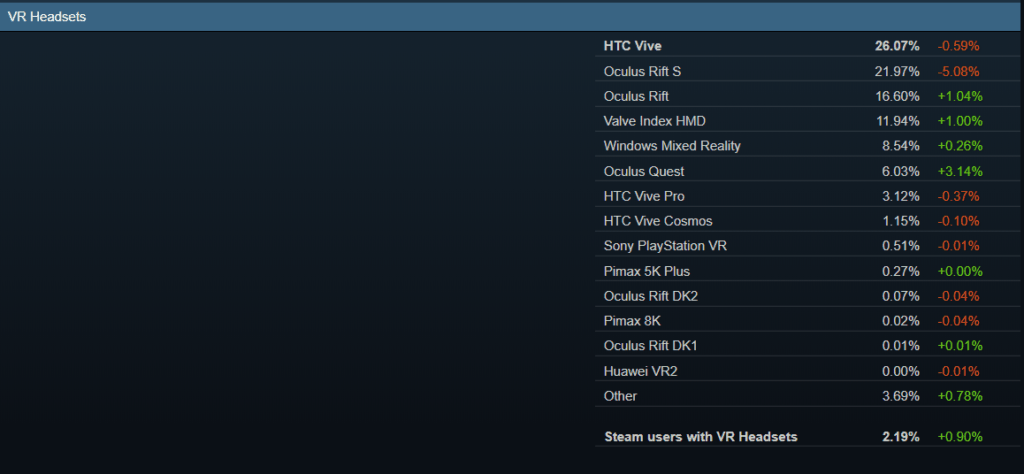Steam User survey for May 2020 reveals big jump in VR headset ownership
There are more users with a VR headset than a 4K monitor
- Last Updated Jun 2, 2020

Every month, Valve performs a user survey, looking at exactly what hardware and software their users have, and then publishes that information. This has a few goals, with a big part of the reasoning being that they want to help publishers and developers releasing games on their platform to know what kind of systems they should be targeting.
The survey data gives information about things like which operating system and which version of that operating system people on Steam are using. As of the most recent survey, 95.05% of Steam users are on Windows, and within that group of users, 85.77% are on Windows 10, and 6.92% are on Windows 7. This kind of statistic helps developers decide whether it is worth supporting older versions of Windows. Some developers might think that the users still on old versions of Windows are worth going out of your way to support, whereas others might look at the majority who have moved over to Windows 10, and decide that that’s a big enough group of users for them to focus on. The Steam user survey helps make these kinds of decisions.
Interestingly, the biggest change with this latest user survey is a big uptick in Steam users with a VR headset. In the March user survey, there was 1.01% of the total Steam user base who had a VR headset. In the April user survey, that had increased to 1.29%, and in May that has climbed to 2.19%.

Plenty of these might be people who specifically invested in a VR headset for Half-Life Alyx, Valve’s showpiece game specifically built around and requiring a VR headset. There have also been supply shortages for some headsets for quite some time now, so perhaps these are players who ordered a headset a while back, and it’s only recently actually arrived.
There are in fact now more users on Steam with a VR headset than there are users with a 4k resolution display. That’s comparing the total number of VR headsets combined, regardless of whether it’s a low, medium or high end headset, but it’s still a very impressive figure. The latest data suggests that Steam has around 95 million active users, so if these figures are representative of the wider user base, that would correlate with a VR install base of 2,080,500 on Steam.
The most popular headset is still the HTC Vive, followed by the Oculus Rift S, original Oculus Rift, and then the Valve Index is gradually climbing up the chart.
Perhaps this will be useful in helping developers decide whether there is an economically viable audience for games that support/require VR going forward. Knowing that there are a couple of million active users buying and playing VR games on Steam is a good indication that there is hope for VR to continue to grow going forward.
Or perhaps this data could have the opposite effect. A game that is popular with the around 93 million active Steam users that don’t have a VR headset is of course far more likely to succeed than one that is popular with a single-digit percentage of users.
It feels like we could be at the point where display resolution alone is no longer an appealing update. 4k and beyond resolutions are firmly in the diminishing returns category, where increasing the pixel count further and further has a bigger impact on game performance and a smaller impact on image quality. 4k resolution screens certainly look nice, but are extremely taxing on graphics cards and other system resources, and don’t offer a fundamentally different experience to a slightly lower resolution display.
If you’ve already got a decent sub-4k resolution monitor, I’d certainly recommend looking into a VR headset before simply seeking to increase resolution further.
There’s no other massive change in the statistics for this month, but if you’re curious about what kind of systems the typical Steam user owns, there’s plenty of interesting details about that over on the full results of the Steam Hardware & Software Survey.
